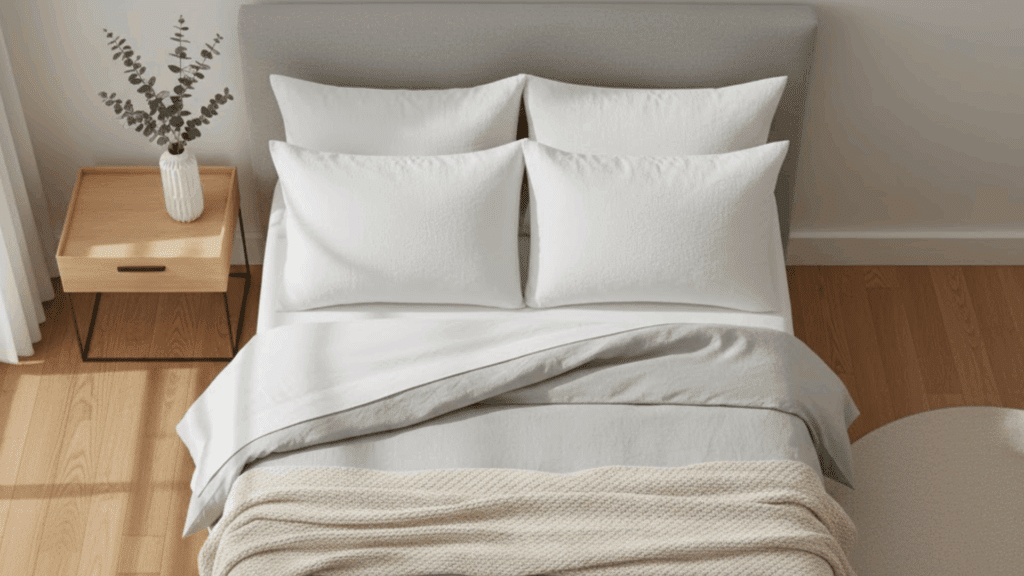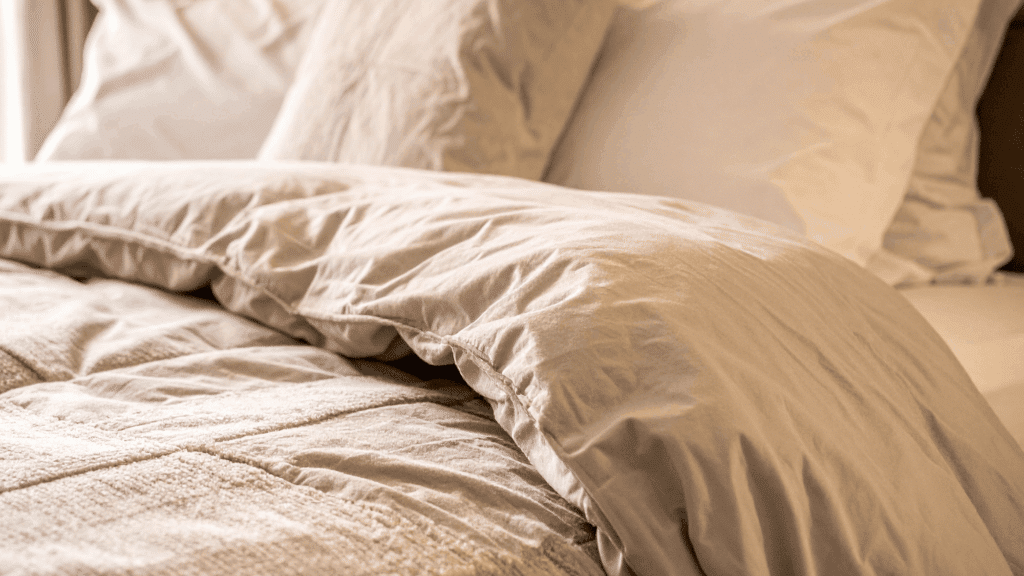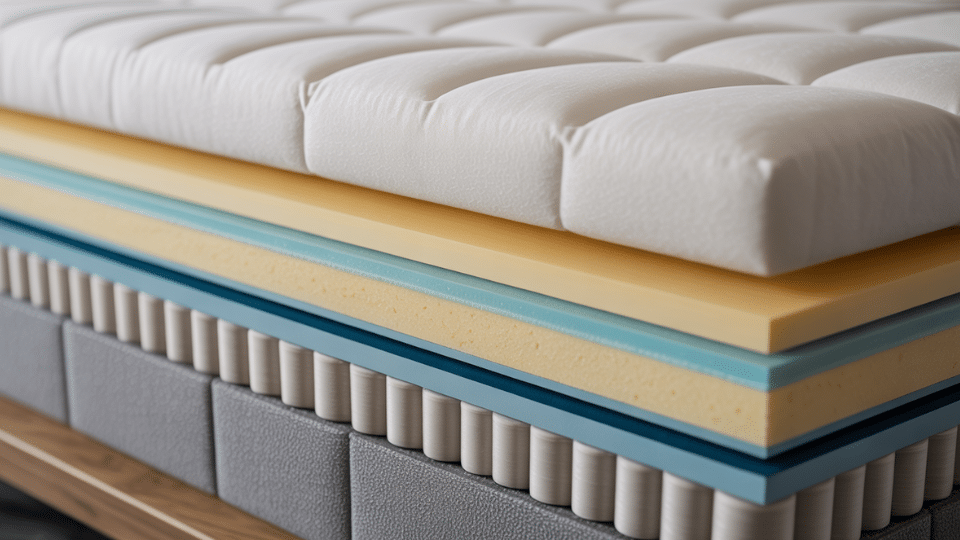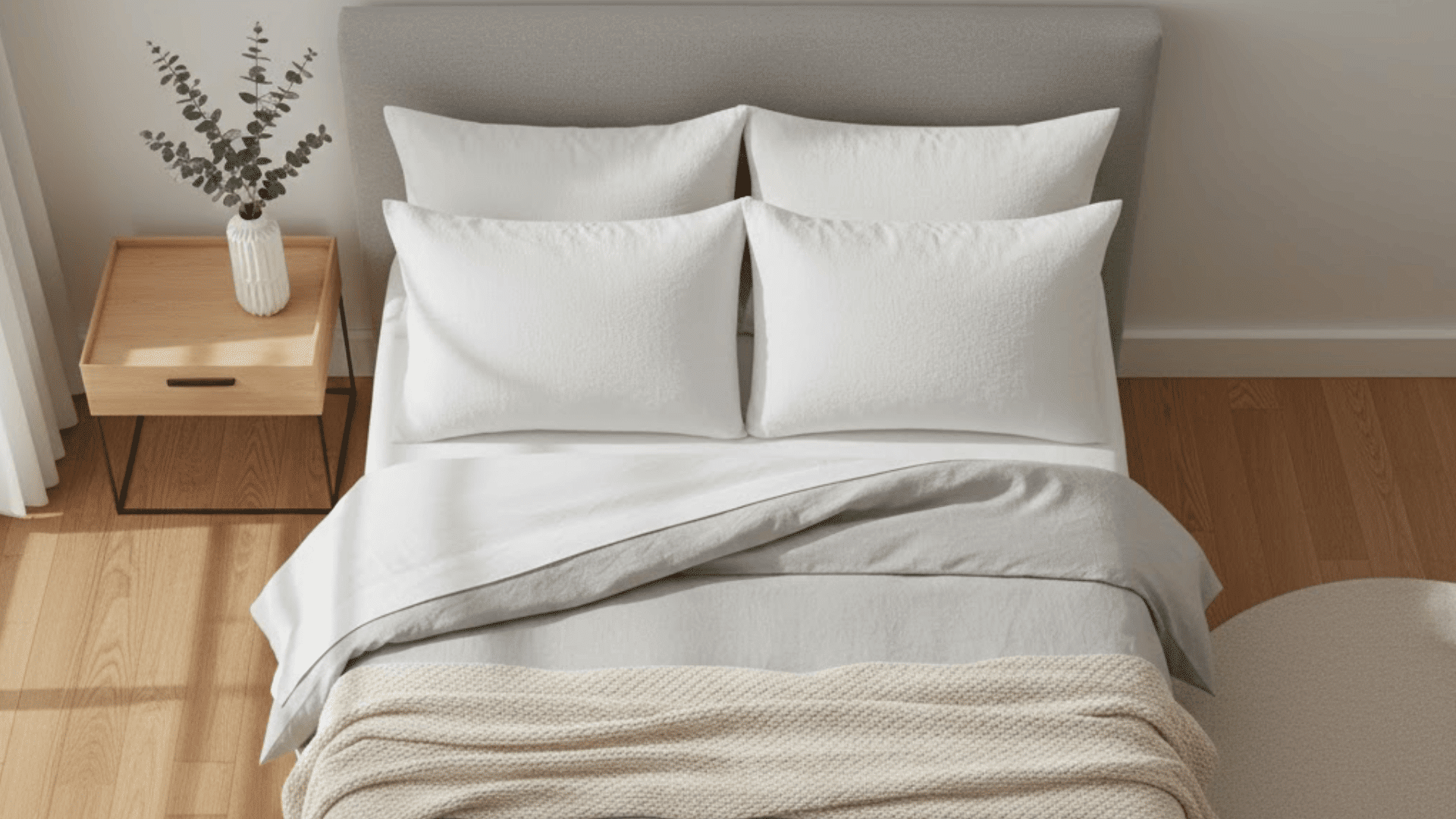I’ll let you in on something most people overlook: your pillow size actually matters more than you’d think. It affects how you sleep, how your neck feels in the morning, and, honestly, how put-together your bed looks.
Queen pillows are the sweet spot I always recommend: they measure twenty by thirty inches, though some brands vary slightly.
I’ve put together this guide to help you make sense of it all. We’ll compare different sizes, figure out pillowcase fit, look at which beds work best with queen pillows, match them to your sleep position, and go over what to look for when you’re ready to buy.
Queen Pillow Dimensions
Queen pillows typically measure 20″ × 30″, or roughly51 × 76 centimeters. Keep in mind that different brands might vary by 1–2 inches in either direction, so always check the specific measurements before buying.
The thickness or loft can range quite a bit, too, depending on whether you’re looking at down, memory foam, or polyester fill.
What makes queen pillows stand out is that extra length. They’re specifically designed to fit queen beds better than standard pillows, giving you more surface area to work with.
This is especially helpful if you’re a side sleeper or someone who shifts positions throughout the night.
Queen Pillow vs. Other Pillow Sizes
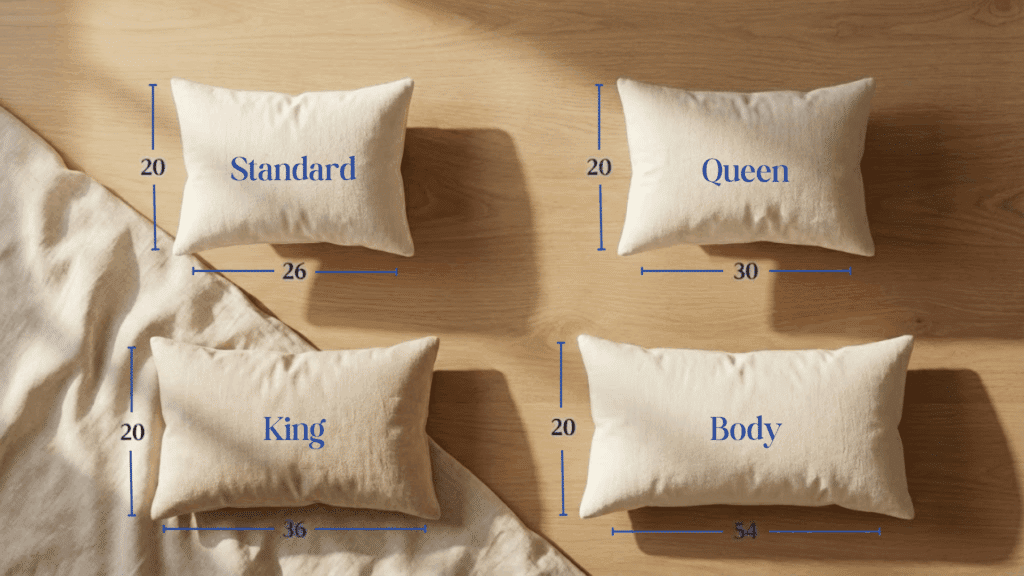
Choosing the right pillow size isn’t just about what fits your bed; it’s about what fits your sleep style.
Let me break down how queen pillows stack up against other popular sizes so you can see where they shine and where other options might work better for you.
How All Pillow Sizes Compare
Here’s a quick overview of how different pillow sizes compare across the board. I’ve included the key details that actually matter when you’re making a decision.
| Pillow Size | Dimensions | Ideal Mattress Size | Best Sleep Positions | Pillowcase Size Compatibility |
|---|---|---|---|---|
| Standard | 20″ × 26″ | Twin, Full | Back, stomach | Standard (20″ × 26″) |
| Queen | 20″ × 30″ | Queen, Full | Side, combination | Queen (20″ × 30″) |
| King | 20″ × 36″ | King, Cal King | All positions | King (20″ × 36″) |
| Body | 20″ × 54″ | Any | Side, pregnancy | Body pillow cases |
Standard vs. Queen
The main difference between standard and the size of queen pillow comes down to that extra 4 inches of length. It might not sound like much, but it makes a noticeable difference in comfort, especially if you move around at night.
Queen pillows look more proportional on full and queen beds, while standard pillows can appear a bit skimpy. As for pillowcases, standard cases won’t fit queen pillows properly; you’ll end up with bunching or gaps that feel awkward.
Queen vs. King
Queen pillows work better if you want more flexibility to shift positions without your head sliding off the edge. King pillows, on the other hand, are ideal for wider beds like king or California king, where they fill out the space nicely.
I typically recommend queen pillows for people who sleep alone or share a queen bed, while king pillows make more sense for couples on larger mattresses who want that extra real estate.
Fit & Comfort: Who is a Queen Pillow Best For?
Queen pillows aren’t for everyone, but if you fall into one of these categories, they’re probably your best bet.
Here’s who benefits most from that extra length and surface area:
- Side Sleepers: The added width gives you more room to nestle in without your head sliding off the edge.
- Combination Sleepers: If you switch positions throughout the night, you’ll appreciate the extra space to move around.
- Couples on Queen Beds: Two queen pillows fit perfectly side-by-side without crowding each other out.
- Hot Sleepers: More surface area means better airflow and room to shift to cooler spots.
- Restless Sleepers: If you toss and turn, queen pillows stay put better than smaller options.
If any of these sound like you, a queen pillow will likely improve both your comfort and sleep quality. It’s all about matching the pillow to how you actually sleep, not just what looks good on your bed.
Bed Size Compatibility Guide
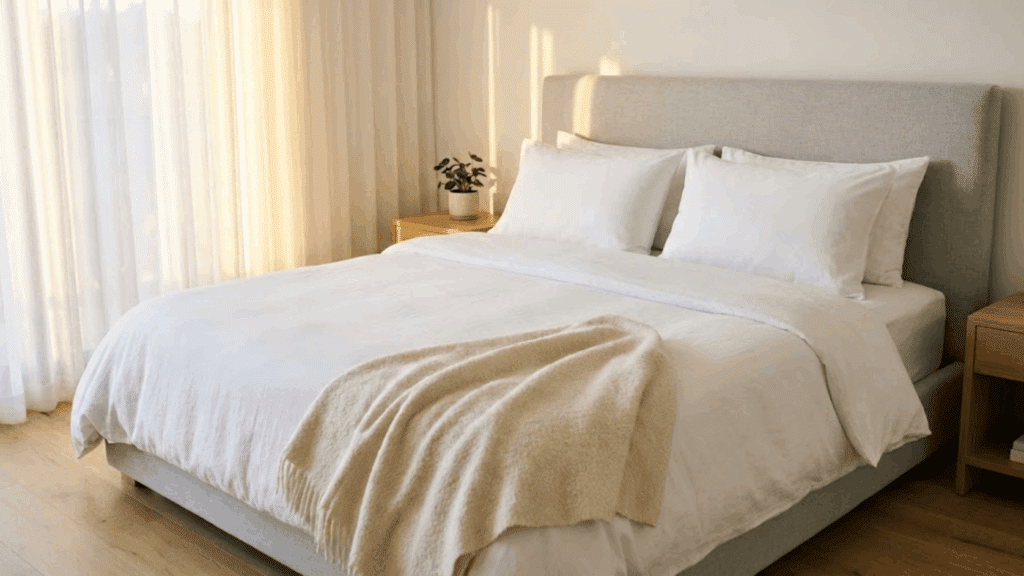
Not every pillow size works with every bed, and queen pillows have their sweet spots. Let me walk you through how they pair with different mattress sizes so you know exactly what to expect before you buy.
1. Twin / Twin XL
A queen pillow will technically fit on a twin or twin XL bed, but it’s going to look a bit oversized. The pillow will likely overhang the edges, which can throw off the visual balance and make your bed feel cramped.
If you’re sleeping on a twin, I’d honestly recommend sticking with standard pillows unless you really need that extra length for comfort reasons. It’s more about proportion than anything else.
2. Full
One queen pillow works beautifully on a full bed; it gives you plenty of sleeping surface without overwhelming the space. If you’re thinking about using two queen pillows, just know they’ll fit, but look pretty snug across the width.
You won’t have much breathing room on either side. For couples sharing a full bed, two queen pillows can work if you don’t mind a cozier setup.
3. Queen
This is where queen pillows really shine. Two queen pillows fit the width of a queen bed almost perfectly, creating a balanced, polished look that’s also incredibly functional.
You get enough space for both sleepers without any awkward gaps or crowding. It’s the pairing I recommend most often because everything just clicks into place: comfort, styling, and practicality all align.
4. King
You can absolutely use queen pillows on a king bed if you prefer more room to move around at night. Some people find king pillows too large and restrictive, so queen pillows offer a nice middle ground.
The trade-off is that two queen pillows won’t fill the entire width, so you’ll have some empty space on either side. If that doesn’t bother you and you value maneuverability over a completely filled headboard, queen pillows work just fine.
Pillowcase & Bedding Considerations
Queen pillowcases are designed to fit 20″ × 30″ pillows, though some brands add an inch or two for ease. Standard pillowcases won’t work well here; they’re too short and create awkward bunching or stretching.
I always recommend getting actual queen-sized cases to avoid that frustration.
When it comes to materials, cotton and linen are my go-to choices for breathability. Envelope closures keep things simple and streamlined, while zipper closures offer a more secure fit.
Just remember that loft matters too. High-loft pillows like down or memory foam can stretch cases more, so you might want something with a bit of give.
How Pillow Size Affects Sleep Quality?
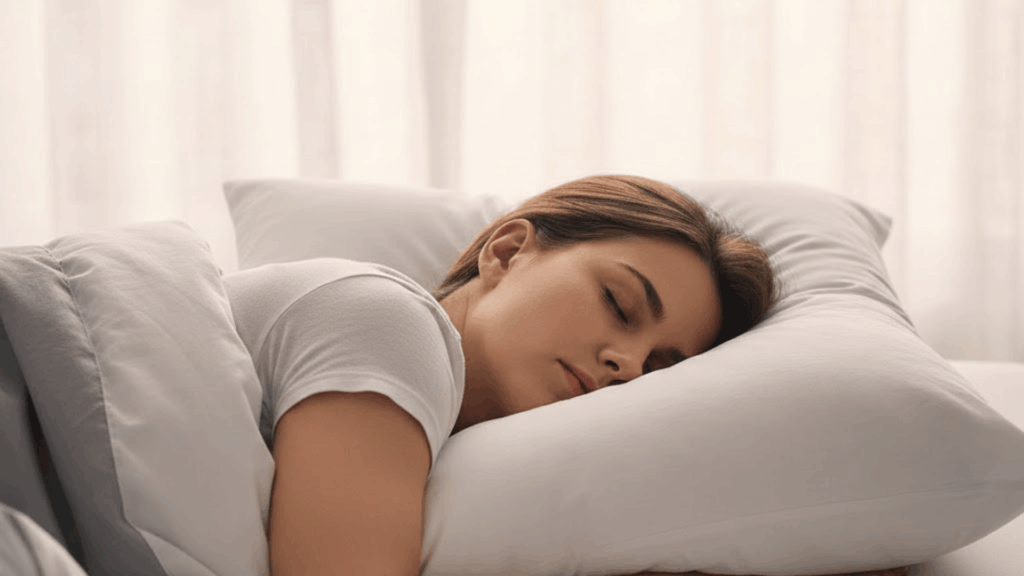
The right pillow size directly impacts your neck alignment and spinal positioning. If your pillow’s too small, your head can slip off during the night, causing you to wake up with a stiff neck.
Queen pillows give you enough surface area to maintain proper alignment, especially if you have broader shoulders that need more support.
The extra length also accommodates tossing and turning without leaving you halfway off the pillow.
And when your pillow size matches your mattress width, like two queen pillows on a queen bed, everything works together to support better, more restful sleep.
Types of Queen Pillows
Queen pillows come in different fill types, and each one offers something unique depending on your sleep style and preferences.
Here’s a breakdown of the most popular options and what makes them stand out:
- Memory Foam (Solid + Shredded): Offers excellent contouring and neck support; solid holds shape, shredded allows customization; best for side and back sleepers; lasts 3 to 5 years.
- Down & Down-Alternative: Soft and moldable with a luxurious feel; down is breathable but pricier, alternative is hypoallergenic; ideal for stomach sleepers; lasts 2 to 3 years.
- Latex: Responsive bounce with natural cooling; stays supportive without sinking; great for combination and hot sleepers; highly durable, lasts 5 to 7 years.
- Hybrid Combinations: Blends materials for balanced support and softness; suits sleepers who want versatility; durability varies, typically 3 to 5 years.
- Cooling Gel Options: Infused with gel to regulate temperature and prevent overheating; perfect for hot sleepers; lasts 3 to 4 years depending on quality.
Choosing the right fill type comes down to how you sleep and what matters most to you, whether that’s support, temperature control, or long-term durability. Match the fill to your needs, and you’ll notice the difference immediately.
Price Expectations & Where to Buy
Pillow prices vary more by fill material than by size, so you’ll find queen pillows across a wide range of price points.
Here’s what you can expect to pay and where to find the best options for your budget.
| Fill Type | Budget | Mid-Range | Premium | Where to Buy |
|---|---|---|---|---|
| Memory Foam | $20 – $40 | $50 – $80 | $100 – $150 | Amazon, Walmart, Casper |
| Down & Down-Alternative | $15 – $30 | $40 – $70 | $150 – $300 | Target, Parachute, Brooklinen |
| Latex | $60 – $90 | $100 – $140 | $150 – $200 | Avocado, Saatva, Sleep On Latex |
| Hybrid | $40 – $60 | $70 – $110 | $120 – $180 | Purple, Coop Home Goods, Tuft & Needle |
| Cooling Gel | $30 – $50 | $60 – $100 | $110 – $160 | Tempur-Pedic, Sleep Number, Amazon |
Must Consider: The move from standard to queen size typically adds only $5 to $15 to the price. What really impacts cost is the quality of materials, construction methods, and brand reputation, not the extra few inches of fabric.
That’s a Wrap
Getting the right queen pillow size can genuinely transform how you sleep. I’ve seen too many people stick with pillows that don’t match their bed or sleep style simply because they didn’t know better.
Now you’ve got all the details on dimensions, compatibility, fill types, and what to look for when shopping.
If you’re upgrading from standard pillows or trying to decide between queen and king, you’re equipped to make the smart choice.
Have questions or want to share your own pillow experience? Drop a comment below; I’d love to hear what works for you.


